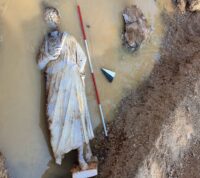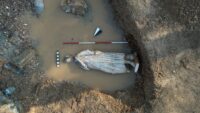 The excavation of the Roman bridges over the Penkalas river in the ancient city of Aizanoi in western Turkey have unearthed a larger-than-life-sized statue of a man. This is the first complete statue unearthed in Aizanoi. The total height of the statue is 2.10 meters (6’11”) and it was found in two parts — the whole body and the head severed at the neck. The man is wearing a himation, a Greek woolen cloak that was draped over a tunic like a lighter-weight version of the Roman toga, over his shoulders forming a sling for his right arm, a posture associated with scholars and orators. Its style marks it as about 2,000 years old.
The excavation of the Roman bridges over the Penkalas river in the ancient city of Aizanoi in western Turkey have unearthed a larger-than-life-sized statue of a man. This is the first complete statue unearthed in Aizanoi. The total height of the statue is 2.10 meters (6’11”) and it was found in two parts — the whole body and the head severed at the neck. The man is wearing a himation, a Greek woolen cloak that was draped over a tunic like a lighter-weight version of the Roman toga, over his shoulders forming a sling for his right arm, a posture associated with scholars and orators. Its style marks it as about 2,000 years old.
Expressing that they were very excited about the statue they found in the recent excavations, [excavation director Gökhan] Coşkun said, “This statue is almost the only intact statue we have found so far. It is a statue of a man with a height of 2 meters and 10 centimeters, missing only half of its pedestal and one foot. Other parts are completely preserved. I hope that we will find this missing piece in 2023.”
The earliest archaeological evidence of settlement at the site dates back the third millennium B.C. The ancient city of Aizanoi established itself as a regional capital in the later Kingdom of Phrygia (ca. 1200-700 B.C.). It took on additional political importance during the Hellenistic period, playing the rope in the tug of war between the Attalid Kingdom of Pergamum and the Kingdom of Bithynia. The game ended in 133 B.C. when Aizanoi was bequeathed to the Roman Republic by the last king of Pergamum, Attalus III.
 Under the Roman Empire it achieved its greatest prosperity. It was already a metropolis in terms of population in the 1st century B.C., but the city’s monumental public buildings and major infrastructure were built by the Roman Emperors. The Temple of Zeus, the macellum (market) inscribed with the Price Edict of Diocletian that is considered the first commercial stock exchange in the world, a combined theater and stadium seating 33,500 that is unique in the Roman world, two public baths and five bridges, two of them still standing today, were built between the 1st and 3rd centuries.
Under the Roman Empire it achieved its greatest prosperity. It was already a metropolis in terms of population in the 1st century B.C., but the city’s monumental public buildings and major infrastructure were built by the Roman Emperors. The Temple of Zeus, the macellum (market) inscribed with the Price Edict of Diocletian that is considered the first commercial stock exchange in the world, a combined theater and stadium seating 33,500 that is unique in the Roman world, two public baths and five bridges, two of them still standing today, were built between the 1st and 3rd centuries.
Statue pieces, mostly heads, have been found in the excavations of the riverbed where the two Roman bridges are being restored, including fragments of very large statues that would have been more than 10 feet high when intact. Earlier this year a rare intact white marble sundial was discovered.